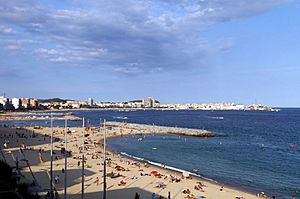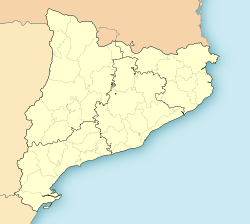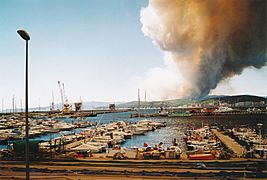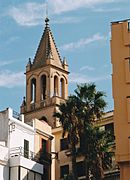Palamós facts for kids
Quick facts for kids
Palamós
|
||
|---|---|---|
|
Municipality
|
||

View of Palamós from the beach of Sant Antoni de Calonge
|
||
|
||
| Country | ||
| Community | ||
| Province | Girona | |
| Comarca | Baix Empordà | |
| Area | ||
| • Total | 14.0 km2 (5.4 sq mi) | |
| Elevation | 30 m (100 ft) | |
| Population
(2018)
|
||
| • Total | 17,898 | |
| • Density | 1,278/km2 (3,311/sq mi) | |
| Demonym(s) | Catalan: Palamosí (m) Palamosina (f) | |
Palamós is a lively town and municipality located on the beautiful Costa Brava in Catalonia, Spain. It sits at the northern end of a large bay, offering stunning views and a great place to visit. Palamós is part of the Baix Empordà region in the Girona province.
The town is easy to reach by road, with the C31 highway passing nearby. This road connects Palamós to other coastal towns and the city of Girona. Nearby towns include Palafrugell, about 8.5 kilometers to the north, and Castell-Platja d'Aro, about 7 kilometers to the south.
Palamós is also a stop on the GR 92 long-distance walking path. This path stretches along the entire Mediterranean coast of Spain. If you walk north from Palamós, you can explore cliffs and beaches like La Fosca. The path then goes inland before returning to the coast through towns like Calella de Palafrugell and Llafranc. Walking south, you can follow the beachfront promenade to Sant Antoni de Calonge and continue along the coast through Platja d'Aro to Sant Feliu de Guíxols.
Contents
Discovering Palamós: A Journey Through Time
Palamós has a long and interesting history, with signs of people living here thousands of years ago.
Ancient Settlements and Early Life
The very first proof of humans in the Palamós area comes from the Dolmen de Montagut. This ancient stone structure is on top of Montagut hill. It dates back to about 3,000 or 2,000 BC. It shows that people lived here even in prehistoric times.
Later, around 1.7 kilometers northeast of the town, there was an early settlement. This was on a rocky point near Platja de Castell beach. It was a stone settlement built by the Iberian Indigetes people. They lived there from the 6th century BC to the 1st century AD.
The Founding of Palamós
Further south, but still north of the modern town, you can find the Castell de Sant Esteve de Mar. This site was used during the Roman period. It was fortified in the 12th century AD.
In 1277, Peter II of Barcelona (also known as Peter III of Aragon) wanted a new port. The old royal port on the River Ter had become too shallow. So, he bought the castle and its land, which included the area where Palamós port is today. Because of this purchase, Palamós was officially founded as a village on December 3, 1279.
The area around Palamós has seen important historical events. The site of the current port was used even before Roman times. It was rebuilt after Peter's purchase in 1277.
In 1285, a famous naval battle took place near the Formigues Islands. These islands are just off the coast of Palamós. The battle was called the Battle of Les Formigues. The Catalan fleet won a big victory against the French fleet.
Notable People from Palamós
Palamós was the birthplace of Frederic Pujulà i Vallès (1877–1962). He was a journalist and a writer. He was also a pioneer in Esperanto literature, which is writing in the international language Esperanto.
Old Railway Connections
Palamós used to have a narrow-gauge railway. This railway connected Palamós to Girona and Banyoles. It reached a main railway line at Flaçà by 1887 and extended to Girona by 1921. The railway served the town until 1956.
Palamós Today: Economy and Activities
Palamós is an important town with a strong connection to the sea.
Fishing and Local Delicacies
The town is a major port. It has one of the last remaining fishing fleets on this part of the Mediterranean coast. Palamós is especially famous for its delicious locally caught prawns from Palamós. These prawns are known as gambes in Catalan.
Tourism and Growth
For a long time, fishing and making cork were the main jobs in Palamós. But in the 1960s, tourism grew very quickly. The town itself kept much of its original look. Most new buildings for tourists were built to the south, in Sant Antoni de Calonge. This area now blends with Palamós.
The bay between Palamós and Sant Antoni de Calonge is very popular. People enjoy sailing, swimming, and windsurfing there. The town's nightlife is centered around the old port. This area is surrounded by many bars and restaurants.
Sports in Palamós
Palamós is home to Palamós CF, the local football club. This club is actually the oldest football club in Catalonia! They share their home ground, the Estadi Palamós Costa Brava, with another club called UE Llagostera. This is because UE Llagostera's own stadium was not big enough for their league.
Gallery
-
The port; in the background a forest fire near Platja d’Aro
See also
 In Spanish: Palamós para niños
In Spanish: Palamós para niños









